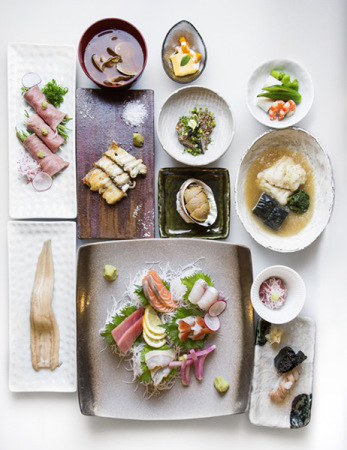
Yotsuba's newly lunched summer set menu for two. (Photo provided to China Daily)
A decade after its founding, Yotsuba, the capital's grandmaster of sushi joints remains singularly focused
"When you are cutting, be incisive; when you are finishing, be sensitive," Kobayashi Atsushi says as he shapes a small glob the size of a golf ball in his hand. "It must be beautiful. In the art of making sushi, beauty equals taste."
Counting the time it takes to cut the meat, he can make one piece of sushi in about 10 seconds, he says.
Before starting to work in Yotsuba sushi restaurant in Beijing in 2004, Atsushi had performed his sushi-making art in Shinjuku, central Tokyo, for 15 years.
Yotsuba is said to be the first genuine sushi restaurant in Beijing.
When Harada Shoichi, the owner of Yotsuba, came to Beijing a year before Atsushi, it was not as though there were no Japanese restaurants, he says. The trouble was that few specialized in sushi.
"What most of them offered was sushi, sashimi, tempura, noodles and all other Japanese odds and ends in one restaurant. It was like a hodgepodge buffet.
"It doesn't work that way in Japan. Usually different restaurants specialize in different sorts of food. There are restaurants for sushi, others for tempura and still others for noodles."
So the following year, he opened Yotsuba, which specializes in sushi. In Japanese, yotsuba is a plant with four leaves on one stalk, although the managers of the Beijing restaurant say that in its case the name refers to customers, suppliers, staff and stakeholders.
Over more than 10 years, Yotsuba has become extremely popular, and there are now three outlets in Beijing, and one in Shenzhen.
We went to the Yansha outlet, which has been freshly renovated, looking to sample what are said to be its top-value business lunches.
The restaurant has an unobtrusive shop front with unimposing rustic wooden doors. Once we entered, we were immersed in a traditional Japanese restaurant setting with warm yellow light and at the entrance were asked to remove our shoes. We could then head for the sushi bar or one of five private dining rooms.
To get a closer look at how the food was prepared, we parked ourselves at the counter, where the chefs were busy working in front of us.
















































